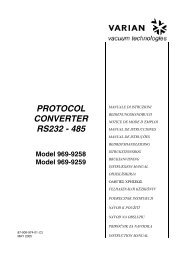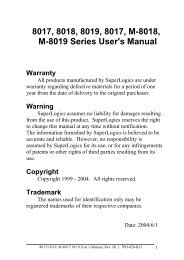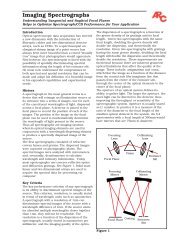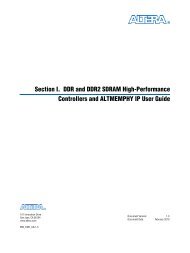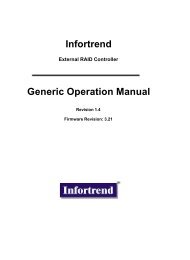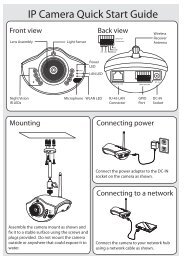Turbo-V 300HT PCB controller
Turbo-V 300HT PCB controller
Turbo-V 300HT PCB controller
Create successful ePaper yourself
Turn your PDF publications into a flip-book with our unique Google optimized e-Paper software.
Connection B (J2)<br />
Logic Output Interconnections<br />
FAULT (+24V)<br />
R 2 (+24V)<br />
START (+24V)<br />
LOW SPEED (+24V)<br />
R 1 (+24V)<br />
SPEED MONITOR (0-10 V)<br />
J2 OUT<br />
15<br />
9<br />
8<br />
1<br />
FAULT<br />
R 2<br />
START<br />
LOW SPEED<br />
R 1<br />
Logic output connector<br />
POWER MONITOR (1 Vdc = 50 W)<br />
POWER AND SPEED MONITOR (COM)<br />
All the logic output from the <strong>controller</strong> must be<br />
connected at P2 mating connector. With the optional<br />
P2 mating connector make the connection with AWG<br />
24 (0.25 mm) or smaller wire to the pins indicated in the<br />
figure to obtain the desired capability. The following<br />
table describes the signals available on the connector.<br />
PIN DESCRIPTION<br />
1-2 Analog output Voltage of power drawn by the<br />
turbopump (pin 2 positive, pin 1 negative). 1<br />
Vdc ≡ 25 W.<br />
4-11 R1 signal 24 V, 60 mA, optically isolated<br />
output (pin 11 positive, pin 4 negative). The<br />
output voltage will be present when the<br />
rotational speed of the pump is higher than the<br />
selected speed threshold.<br />
5-12 LOW SPEED signal, 24 V, 60 mA, optically<br />
isolated output (pin 12 positive, pin 5<br />
6-13<br />
negative). The output voltage will be present<br />
when the low speed mode is selected, either<br />
through the hand held terminal or the remote<br />
signal.<br />
START signal 24 V, 60 mA, optically isolated<br />
output (pin 13 positive, pin 6 negative).<br />
The output Voltage will be present when the<br />
START pushbutton on hand held terminal is<br />
pressed, or the remote start is present, until<br />
NORMAL operation is reached.<br />
TECHNICAL INFORMATION<br />
PIN DESCRIPTION<br />
7-14 R2 signal 24 V, 60 mA, optically isolated<br />
output (pin 14 positive, pin 7 negative).<br />
The output Voltage will be present upon the<br />
programmed condition delay YES or delay NO<br />
(see the cycle diagram in the following pages).<br />
If YES is selected, R2 is off and the output is<br />
zero over all run up time, then:<br />
a) If running speed > speed threshold<br />
R2 = OFF<br />
b) If running speed < speed threshold<br />
R2 = ON<br />
If NO is selected:<br />
a) If running speed > speed threshold<br />
R2 = OFF<br />
b) If running speed < speed threshold<br />
R2 = ON<br />
8-15 FAULT signal 24 V, 60 mA, optically isolated<br />
output (pin 15 positive pin 8 negative).<br />
The output voltage will be present when a fault<br />
condition is detected.<br />
The following figure shows a typical logic output<br />
connection (relay coil) but any other device may be<br />
connected e.g. a LED, a computer, etc., and the related<br />
simplified circuit of the <strong>controller</strong>.<br />
15<br />
9<br />
8<br />
1<br />
73 87-900-884-01 (D)<br />
15<br />
9<br />
Typical output connection<br />
8<br />
1<br />
+24 V<br />
+ 24




